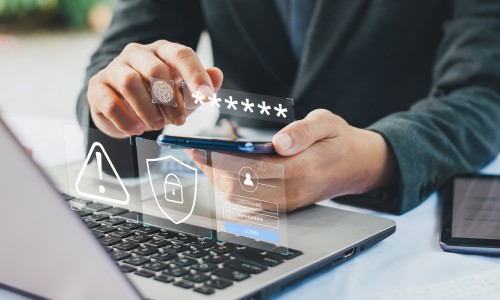
Common Cybersecurity Mistakes and How to Avoid Them
9 January 2025
Cybercrime is on an alarming rise, with a projected global cost of $9.5 trillion by the end of 2024 and expected to soar to $10.5 trillion annually by 2025. These figures are a reminder of the digital threats that everyone faces in the digital age. Every click, every download, and every digital transaction can expose you to potential cyber threats.
Yet, many of these risks stem from common mistakes that, surprisingly, can be avoided with the right knowledge and strategies. From weak passwords to disregarding basic security updates, the pitfalls are many, and the consequences are too significant to ignore.
Could your daily online habits be inviting cybercriminals into your life? Read on to discover common cybersecurity mistakes and how to avoid them.
Weak Password Practices
Many people still use simple, easy-to-guess passwords like ‘123456’ or ‘password’ across multiple accounts. This approach makes it a breeze for hackers to gain access not only to one account but potentially to a slew of them if they uncover a single password. Reusing the same password for different sites or failing to update passwords regularly can also leave you vulnerable to attacks.
It’s crucial to strengthen your passwords. Start by using a mix of letters, numbers, and special characters to create more complex passwords that are tougher to crack. Aim for at least 12 characters, and never use obvious substitutions like ‘pa$$word’ that are still easy to predict.
To manage multiple strong passwords, consider using a reputable password manager. These tools can generate and store robust passwords for you, reducing the burden of remembering each one while keeping them secure. You should also make it a routine to change your passwords periodically.
Overlooking Software Updates
Delaying or ignoring software updates might seem like a minor oversight, but it’s a significant vulnerability in cybersecurity. Updates often include patches for security flaws that, if unaddressed, can open the door to hackers. It’s easy to click ‘remind me later’ on an update notification, but each delay extends the window of opportunity for cyber-attacks.
To avoid this risk, enable automatic updates on your software and devices. This practice ensures you’re running the most secure version available without having to remember to update each time manually.
Falling for Phishing Scams
Phishing scams cleverly mimic legitimate communications, tricking you into handing over sensitive information. Whether it’s a fake email from your bank or a spoofed company notice, these scams are designed to make you act without thinking. The consequences of falling for such tricks can be severe, leading to the loss of personal data, financial resources, and compromised security at your workplace.
To guard against phishing, always verify the authenticity of requests for personal information. Be sceptical of unsolicited communications, and double-check the sender’s details. Also, make it a habit to never click on links or download attachments from unknown or suspicious sources.
Not Using Multi-Factor Authentication (MFA)
Skipping multi-factor authentication (MFA) is like leaving your front door unlocked: it might seem convenient, but it drastically increases your risk of a break-in. MFA adds an extra layer of security by requiring two or more verification methods to access your accounts, not just a password.
This could be a code sent to your phone, a fingerprint, or facial recognition. This method ensures that even if your password is compromised, the chances of an unauthorised user accessing your accounts remain low. Without MFA, you’re relying solely on passwords that can be cracked, guessed, or stolen.
To bolster your defences, enable MFA on all platforms that offer it. You can activate it through your account settings, selecting from options that might include receiving a code via SMS, using an authenticator app, or employing biometric verification.
Lax Security on Mobile Devices
As mobile devices become central to both personal and professional activities, they accumulate vast amounts of sensitive data. Yet, many overlook the importance of securing these devices. Cybercriminals target mobile platforms to exploit weaknesses, such as unprotected Wi-Fi connections and outdated software.
To enhance your mobile security, start by using strong, unique passwords and enabling biometric safeguards like fingerprint or facial recognition. Regularly updating your device’s operating system and apps ensures you benefit from the latest security patches. You should also be cautious about the networks you connect to; using a trusted VPN on public Wi-Fi can provide a secure link, protecting your data from prying eyes.
Failing to Educate Staff
Employees are often the first line of defence against cyber threats, yet many organisations fail to equip them with the necessary knowledge and skills. This leaves a significant gap in your security strategy, making your business vulnerable to attacks like phishing and malware.
To address this, you should conduct regular training sessions to educate your team on recognising suspicious activities and following best practices. Ensuring that everyone understands the importance of strong passwords, the risks of clicking unknown links, and the value of securing sensitive data can reduce the likelihood of a breach.
Work With ICT Solutions for Enhanced Cybersecurity
Recognising common cybersecurity mistakes and knowing how to avoid them is crucial for maintaining digital safety. Whether it’s using strong passwords, keeping software updated, enabling MFA, or educating staff, each step strengthens your defences against cyber threats. Staying cyber-safe is essential for both individuals and organisations to prevent data breaches and financial losses.
If you’re looking to bolster your cybersecurity posture, ICT Solutions is here to help. With over ten years of experience, we offer comprehensive IT support and cybersecurity services for businesses in Liverpool and across the UK. Contact us today to safeguard your business from evolving cyber threats.



